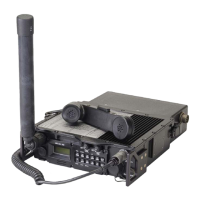General Dynamics C4 Systems URC-200 (V2)
75
5.3.2 Receiver Tests
WARNING
DO NOT THROW BATTERIES IN THE TRASH
Dispose of all used batteries in accordance with all manufacturer, Federal, State
and local laws and regulations.
Improper handling, reverse-current operation or high environmental
temperatures may cause internally generated heat, fire, or toxic materials and
gasses to be released from the battery.
The following precautions must be strictly observed to prevent injury to
personnel or damage to equipment:
• DO NOT heat, incinerate, crush, puncture, disassemble or mutilate the
batteries.
• DO NOT recharge primary (Non- rechargeable) batteries.
• DO NOT store in equipment during periods of non-use for more than 30
days.
• DO follow all safety instructions that come with the batteries or printed on
them.
• TURN OFF the equipment immediately if you (1) detect that the battery
compartment is becoming unduly hot, (2) hear battery cells venting (hissing), or
(3) smell irritating sulfur dioxide gas. Remove the battery only after it is cool
(after 30 to 60 minutes), and dispose of it by following approved procedures.
The following tests evaluate the performance of the receiver circuits. The functions that will be
tested are receiver sensitivity and distortion at various frequencies in AM and FM, and in CT and
PT modes. Squelch sensitivity will also be checked. If the transceiver fails any of the tests, or if it
cannot be adjusted to the specified values, it must be sent to General Dynamics C4 Systems for
repair.
5.3.2.1 FM PT Sensitivity and Distortion
1. Set up the test equipment as shown in Figure 16. Connect the
VERT/SINAD/DIST/DVM/COUNTER IN connector on the R2600 to Pin E (PT
OUT) of the Breakout Box. Pin A or D of the remote connector is return ground.
2. Set the input power supply to 28 ± 01 VDC.

